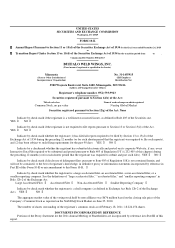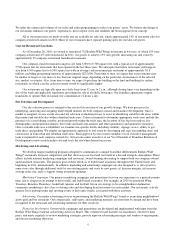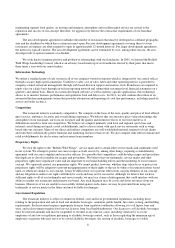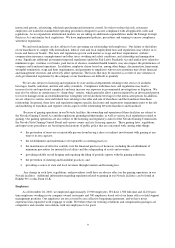Buffalo Wild Wings 2010 Annual Report Download - page 5
Download and view the complete annual report
Please find page 5 of the 2010 Buffalo Wild Wings annual report below. You can navigate through the pages in the report by either clicking on the pages listed below, or by using the keyword search tool below to find specific information within the annual report.5
We tailor the content and volume of our video and audio programming to reflect our guests’ tastes. We believe the design of
our restaurants enhances our guests’ experiences, drives repeat visits and solidifies the broad appeal of our concept.
All of our menu items are made-to-order and are available for take-out, which approximated 14% of restaurant sales for
company-owned restaurants in 2010. Many of our restaurants have separate parking spots for our take-out guests.
Current Restaurant Locations
As of December 26, 2010, we owned or franchised 732 Buffalo Wild Wings restaurants in 44 states, of which 259 were
company-owned and 473 were franchised. In 2011, our goal is to achieve 13% unit growth, increasing our unit count by
approximately 95 company-owned and franchised restaurants.
Our company-owned restaurants range in size from 3,900 to 9,700 square feet, with a typical size of approximately
5,700 square feet for restaurants that have opened in the last three years. We anticipate that future restaurants will range in
size from 4,500 square feet to 6,500 square feet with an average cash investment per restaurant of approximately $1.8
million, excluding preopening expenses of approximately $225,000. From time to time, we expect that our restaurants may
be smaller or larger or cost more or less than our targeted range, depending on the particular circumstances of the selected
site, market, or country. Also, from time to time, we expect to purchase the building or the land and building for certain
restaurants, in which case the cash investment would be significantly higher.
Our restaurants are typically open on a daily basis from 11 a.m. to 2 a.m., although closing times vary depending on the
day of the week and applicable regulations governing the sale of alcoholic beverages. Our franchise agreements require
franchisees to operate their restaurants for a minimum of 12 hours a day.
Site Selection and Development
Our site selection process is integral to the successful execution of our growth strategy. We have processes for
identifying, analyzing and assigning undeveloped markets for both company-owned and franchise development. Once a
market is assigned, we use a trade area and site selection evaluation process to assist in identifying suitable trade areas within
that market and suitable sites within identified trade areas. Criteria examined to determine appropriate trade areas include the
presence of a casual dining corridor, projected growth within the trade area, the locations of key big box retailers, key
demographics and population density, drive time and trade area analysis and other quantitative and qualitative measures.
Once a suitable trade area is identified, we examine site-specific details including visibility, signage, access, ability to get
trade dress, and parking. We employ an opportunistic approach to real estate by developing end caps, freestanding units, and
conversions in both urban and suburban trade areas. Final approval by one or more members of our executive management
team is required for each company-owned site. At least one senior executive or our Vice President of Franchise Relations &
Development reviews each franchise site and visits the site when deemed necessary.
Marketing and Advertising
We develop unique marketing programs designed to communicate a unique brand that differentiates Buffalo Wild
Wings
®
restaurants from our competitors and that showcases our food and our brand in a fun and energetic atmosphere. These
efforts include national marketing campaigns and irreverent, award-winning advertising to support both our company-owned
and franchised restaurants. The primary goal of these efforts is to build brand awareness throughout the United States and,
beginning in 2011, internationally. In addition, marketing and advertising campaigns are also designed to: i) drive positive
same-store sales through additional visits by our existing guests and visits by new guests, ii) increase margins, iii) increase
average order size, and iv) support strong restaurant openings.
Marketing Campaigns. Our primary marketing campaigns and promotions focus on our experience or a particular menu
item, day or daypart in an attempt to drive traffic and build brand awareness. For example, in 2010 we promoted Wing
Tuesdays, Boneless Thursdays, basketball, takeout, and football. Given our strategy to be a neighborhood destination,
community marketing is also a key to driving sales and developing brand awareness in each market. Our restaurants actively
sponsor local sporting teams and sporting events to drive guest traffic associated with those activities.
Advertising. Our media advertising focuses on positioning the Buffalo Wild Wings
®
brand as an inviting neighborhood
sports grill and bar restaurant. Our commercials, radio spots, and marketing materials are irreverent by design and have been
recognized in the restaurant and advertising industries for their creativity.
Franchise Involvement. System-wide campaigns and promotions are developed and implemented with input from the
Buffalo Wild Wings National Advertising Advisory Board. This volunteer board includes six franchisees, elected by their
peers, and meets regularly to review marketing strategies, provide input on advertising messages and vendor co-op programs,
and discuss marketing objectives.


















